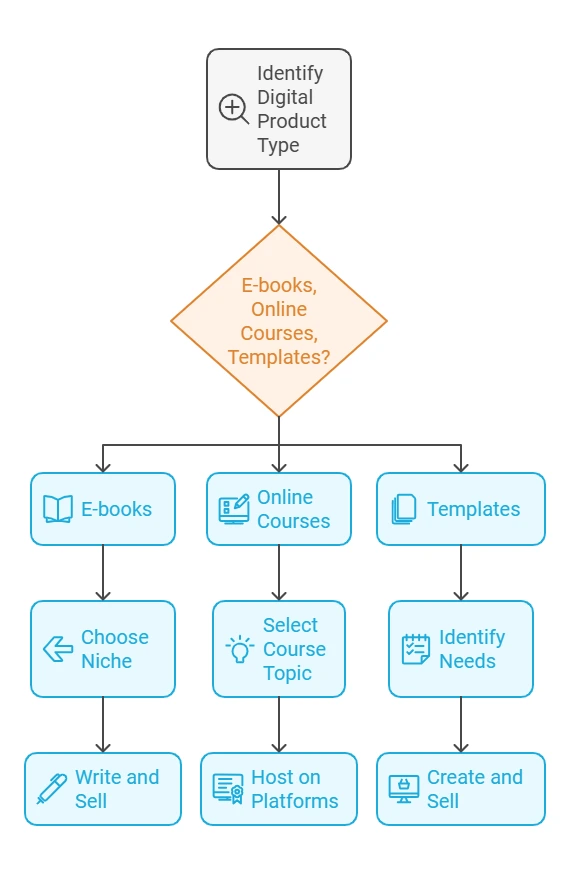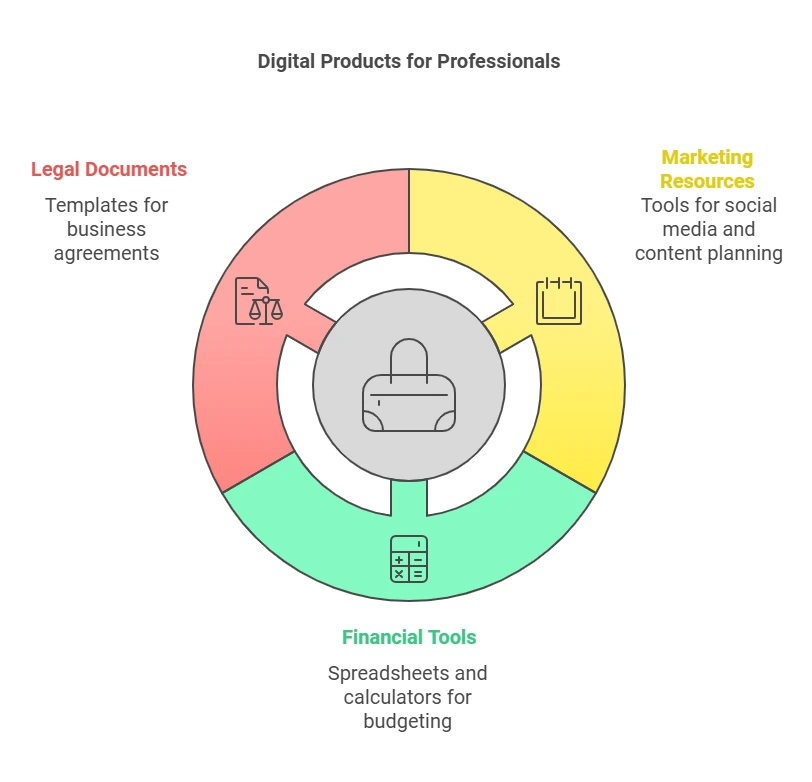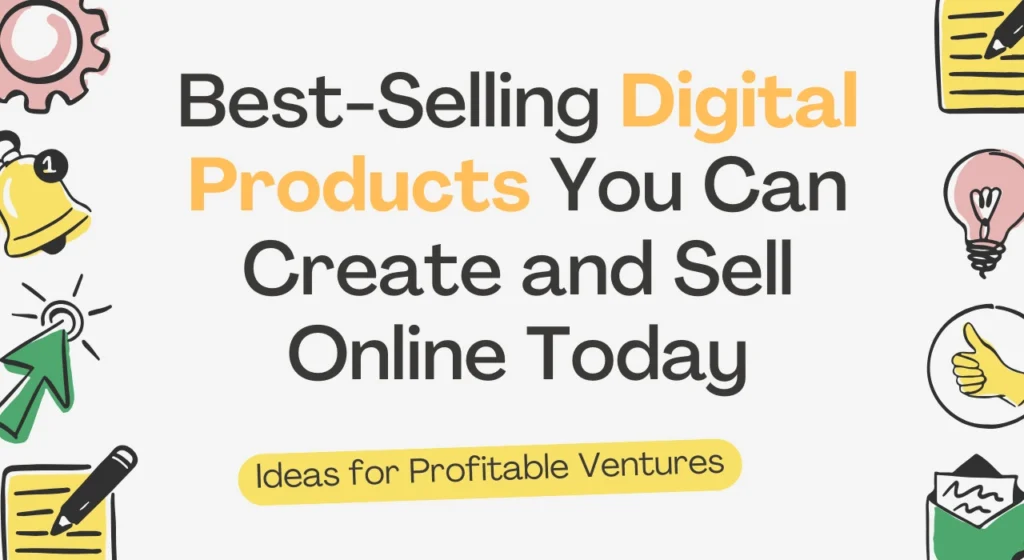Table of Contents
Introduction
In a world where the internet is our global marketplace, digital products have emerged as a goldmine for creators and entrepreneurs alike. Whether you’re looking for a side hustle or aiming to build a full-fledged business, selling digital products offers limitless opportunities. Not only can they generate passive income, but they also allow you to share your expertise with a global audience. Let’s dive into why digital products are the perfect venture in 2024 and explore how creators can tap into this thriving market.
Why Digital Products Are Profitable in 2025
Digital products are booming in 2025 for several reasons. First, they require minimal overhead compared to physical goods. Once created, a digital product can be sold infinitely without worrying about inventory, shipping, or manufacturing costs. Secondly, people are increasingly turning to the internet for solutions, whether it’s learning new skills, improving their productivity, or accessing creative resources. This creates an evergreen demand for well-crafted digital products.
Moreover, technological advancements and widespread internet access have made it easier than ever to reach potential customers worldwide. Platforms like Gumroad, Etsy, and Teachable provide user-friendly solutions to market and sell digital goods. In short, digital products offer scalability and profitability unmatched by traditional businesses.
Understanding the Demand for Digital Products
The demand for digital products stems from their convenience, versatility, and accessibility. Consumers love the instant gratification of purchasing a product online and accessing it immediately. Businesses, educators, and individuals constantly seek tools and resources to simplify their lives, enhance their skills, or solve specific problems.
Digital products also cater to niche markets that are often underserved by traditional retail. From unique templates for small businesses to specialized online courses, there’s something for everyone. This adaptability ensures a steady and growing demand.
Benefits of Creating and Selling Digital Products Online
Creating and selling digital products online comes with countless advantages:
- Low Startup Costs: Unlike physical products, you don’t need a factory, warehouse, or shipping service.
- Passive Income: Once your product is live, it can continue to generate income with minimal ongoing effort.
- Global Reach: The internet allows you to market to audiences anywhere in the world.
- Creative Freedom: You can craft products that align with your skills, passions, and expertise.
- Scalability: There’s no limit to how many customers you can serve, and you can continuously improve or expand your offerings.
Want to leverage AI to build a profitable online business but don’t know where to start? 🚀 Our beginner-friendly guide walks you through everything you need to know to launch and scale with AI. Don’t miss out—grab your copy of “How to Build an AI-Powered Online Business: A Beginner’s Guide” today! 👉 Get your eBook now!
Part 1: Digital Products for Creators

1. E-books and Guides
Popular Niches for E-books
E-books remain a popular digital product because they’re versatile and cater to various audiences. High-demand niches include personal development, business and entrepreneurship, health and fitness, DIY projects, and hobbies like photography or cooking. Finding a niche that aligns with your expertise ensures authenticity and increases your chances of success.
Step-by-Step Guide to Writing and Selling an E-book
- Choose Your Topic: Focus on a specific problem or interest that you can address comprehensively.
- Outline Your Content: Break down the topic into clear chapters or sections to organize your thoughts.
- Write and Edit: Write engaging content, then refine it with thorough editing or professional help.
- Design Your E-book: Use tools like Canva or Adobe InDesign to create an appealing and professional layout.
- Choose a Platform: Upload and sell your e-book on platforms like Amazon Kindle, Gumroad, or your website.
- Market Your E-book: Promote it through social media, email newsletters, and partnerships with influencers.
2. Online Courses
Top Course Topics That Sell
Online courses are thriving as people increasingly turn to e-learning to upskill or pursue their passions. Popular topics include:
- Digital marketing and social media
- Coding and software development
- Fitness and nutrition
- Creative skills like writing, graphic design, and video editing
- Personal finance and investment
Platforms to Host and Market Your Course
Platforms like Teachable, Udemy, and Thinkific simplify course hosting and marketing. They provide tools for creating interactive lessons, tracking student progress, and even running promotions. Additionally, you can leverage social media ads, YouTube tutorials, or blog posts to drive traffic to your course.
3. Templates and Toolkits
Best-Selling Business and Personal Templates
Templates save users time and effort, making them highly sought-after. Best-selling examples include:
- Business templates: Invoice designs, project management tools, pitch decks
- Personal templates: Resume layouts, budget trackers, and daily planners
- Creative templates: Social media graphics, website wireframes, and branding kits
How to Create Customizable and Reusable Templates
- Identify Your Audience’s Needs: Understand the type of template your target audience requires.
- Use Design Software: Tools like Canva, Adobe Illustrator, or Figma are ideal for creating templates.
- Focus on Customization: Ensure your templates are easy to modify by including editable text, colors, and formats.
- Bundle Your Templates: Offer themed collections to increase perceived value.
- Choose the Right Marketplace: Sell your templates on Etsy, Creative Market, or your personal website.
By leveraging your creativity and expertise, you can craft digital products that not only fulfill market demands but also allow you to build a profitable online business. The next step? Start creating!
Part 2: Digital Products for Designers

4. Graphic Design Assets
Logos, Icons, and Vector Art
Graphic design assets are in constant demand by businesses, content creators, and developers. Logos are essential for branding, icons are used in websites and apps, and vector art appeals to designers who need scalable graphics for various projects. High-quality, unique, and customizable assets stand out in this competitive market. Trending styles include minimalist designs, flat icons, and illustrations with bold colors and clean lines.
Where to Sell Graphic Design Assets
Selling graphic design assets has never been easier, thanks to various platforms catering to creators. Consider uploading your work to:
- Creative Market: Ideal for templates, logos, and vector designs.
- Envato Elements: A subscription-based marketplace for designers.
- Etsy: A great choice for unique and niche graphic designs.
- Your Website: Selling directly ensures you keep a higher percentage of the profits.
With effective marketing and a strong portfolio, graphic designers can enjoy steady revenue from selling their creations.
5. Printables
Trending Printables: Planners, Calendars, and Checklists
Printables are a favorite among consumers looking for easy and affordable solutions for organization and productivity. Trending items include:
- Planners: Daily, weekly, and monthly formats.
- Calendars: Customizable designs for personal and business use.
- Checklists: Focused on specific needs like wedding planning, meal prepping, or goal tracking.
Personalized printables are particularly popular, as users love the ability to tailor designs to their preferences.
How to Make Editable Printables Using Design Tools
- Start with a Design Tool: Canva and Adobe InDesign are excellent for creating professional printables.
- Focus on User Experience: Ensure your printables are easy to read and visually appealing.
- Incorporate Editable Elements: Save files as PDFs with editable fields to increase versatility.
- Offer Bundles: Group similar items (e.g., a wedding planner kit) to boost sales value.
- Host on the Right Platforms: Etsy, Gumroad, and your website are ideal marketplaces for printables.
6. Stock Photos and Videos
High-Demand Niches in Stock Photography
Stock photos and videos remain a lucrative digital product, especially in specific niches like:
- Lifestyle: Authentic moments in diverse settings.
- Business: Professional workplace imagery.
- Nature and Travel: Scenic landscapes and unique destinations.
- Technology: Futuristic visuals, gadgets, and digital environments.
Keeping up with trends, such as diversity and inclusivity, ensures your portfolio attracts a broader audience.
How to Sell on Stock Platforms
- Capture Quality Content: Invest in good equipment and editing software for polished results.
- Curate a Niche Portfolio: Focus on specific themes to establish expertise.
- Choose the Right Platform: Shutterstock, Adobe Stock, and Alamy are leading marketplaces.
- Tag Your Content Properly: Use accurate keywords to improve discoverability.
- Offer Exclusive Bundles: Platforms often reward exclusive content with better exposure and revenue.
Part 3: Digital Products for Developers
7. Mobile Apps and Software Tools
In-Demand App Categories
The mobile app market is booming, with top categories including:
- Health and Fitness: Workout planners, meditation apps, and calorie trackers.
- Education: E-learning platforms and language apps.
- Productivity: Task managers and time-tracking tools.
- Entertainment: Casual games and streaming platforms.
Steps to Monetize Your Mobile App
- Freemium Model: Offer basic features for free, with premium upgrades.
- In-App Purchases: Sell additional tools, levels, or services.
- Subscriptions: Charge monthly or yearly fees for ongoing value.
- Ads: Use display ads strategically without disrupting user experience.
- Sponsorships: Partner with brands for co-branded content.
8. Website Themes and Plugins
Creating Themes for Popular CMS Platforms
Website themes are always in demand, particularly for platforms like WordPress, Shopify, and Wix. To create a successful theme:
- Focus on Niche Needs: For example, a photography portfolio theme or a small business shop template.
- Ensure Responsiveness: Mobile-friendly designs are essential.
- Optimize for SEO: Built-in SEO features add value for buyers.
Monetizing Plugins: Subscription vs. One-Time Purchase
Plugins are small software solutions that enhance website functionality. To monetize them:
- Subscription Model: Charge users recurring fees for updates and support.
- One-Time Purchase: Provide a lifetime license, popular for smaller tools.
Both models have their merits, but subscriptions offer long-term revenue potential.
9. Code Snippets and Automation Tools
Why Developers Need Ready-Made Code Snippets
Developers love code snippets because they save time and simplify workflows. Whether it’s a pre-built function, automation script, or widget, ready-made code allows developers to focus on bigger challenges.
Where to Sell Code Snippets and Scripts
- CodeCanyon: A marketplace for all types of developer tools.
- GitHub Sponsors: Sell directly or seek sponsorship for your code.
- Your Blog or Website: Showcase and monetize your scripts with tutorials and demos.
- Subscription Platforms: Offer a library of snippets for a recurring fee.
By creating and selling these digital products, developers can monetize their expertise while helping others streamline their projects.
Each of these digital product categories offers unique opportunities for designers and developers to turn their skills into thriving online businesses. Whether you specialize in graphic design or coding, there’s a market eager for your creations.
Part 4: Digital Products for Creators
11. Podcasts and Audiobooks
How to Monetize Podcasts Beyond Ads
Podcasting is booming, but ads aren’t the only way to earn. Consider these strategies:
- Exclusive Content: Offer premium episodes or behind-the-scenes access through platforms like Patreon.
- Merchandise: Sell branded items to loyal listeners.
- Live Events: Host live shows or Q&A sessions for fans.
- Sponsorships: Partner with brands aligned with your audience’s interests.
A niche podcast with a dedicated following can be surprisingly profitable.
Selling Audiobooks on Popular Marketplaces
Audiobooks are a fantastic option for writers and voiceover artists. Platforms like Audible and Findaway Voices make it easy to reach a global audience. To succeed, focus on creating engaging content, investing in professional narration, and using effective metadata to improve discoverability.
Part 5: Digital Products for Business Professionals

13. Marketing Resources
Creating Social Media Kits and Content Calendars
Social media managers and entrepreneurs crave tools to streamline their work. Popular marketing resources include:
- Social Media Kits: Pre-designed templates for posts, stories, and ads.
- Content Calendars: Monthly or yearly planners with ready-to-use content ideas.
Well-organized and aesthetically pleasing resources save time and enhance marketing efforts, making them highly sought after.
Selling Ready-to-Use Marketing Plans
Marketing plans tailored for specific industries are in high demand. Create templates that include:
- Strategies for Audience Engagement: Step-by-step plans for social media, email, and other channels.
- Metrics for Success: Tools for tracking KPIs and ROI.
These resources are especially valuable to small businesses without dedicated marketing teams.
14. Financial Tools and Calculators
Best-Selling Spreadsheets and Financial Templates
From budgeting to business forecasting, financial tools are a staple for professionals. Bestsellers include:
- Personal Budget Trackers: Help individuals manage expenses and savings.
- Business Financial Models: Ideal for startups planning growth strategies.
- Tax Calculators: Streamline tax filing for freelancers and entrepreneurs.
Monetizing Personal Finance and Budgeting Tools
Create tools with user-friendly features like pre-set formulas and customizable fields. Platforms like Gumroad, Etsy, and your website make it easy to market these resources to a global audience.
15. Legal Documents and Agreements
High-Demand Legal Templates for Small Businesses
Many small businesses need ready-to-use legal templates to save time and money. In-demand templates include:
- NDAs (Non-Disclosure Agreements): Protect confidential information.
- Freelance Contracts: Ensure clear terms for gig workers.
- Terms and Conditions: Essential for e-commerce and service websites.
How to Ensure Your Templates Are Legally Sound
Collaborate with legal professionals to ensure accuracy and compliance. Clearly state that your templates are for general use and recommend consulting a lawyer for customization. Selling legally sound templates builds trust and positions you as a credible resource in your niche.
Creators, and business professionals have endless opportunities to monetize their expertise through digital products. By understanding market demands and delivering high-quality solutions, anyone can turn their skills into sustainable income.
Part 6: Emerging Digital Product Trends
16. AI-Powered Tools and Content
Popular AI-Based Products to Develop
Artificial intelligence is revolutionizing the digital product landscape. Developers, marketers, and educators are leveraging AI to create tools that simplify complex tasks. Popular AI-powered products include:
- Chatbots: Automate customer support for businesses.
- AI Content Generators: Tools for producing blog posts, social media captions, or even entire e-books.
- Image and Video Editing Software: AI-powered tools that enhance photos or generate visuals from text prompts.
The versatility and demand for AI-based solutions make them a lucrative digital product category.
Using ChatGPT and Other AI Tools for Digital Product Creation
Platforms like ChatGPT empower creators to develop innovative products without coding expertise. Examples include:
- Custom Chatbots: Tailored for specific industries like healthcare or retail.
- Content Ideation Tools: Helping writers brainstorm titles, scripts, and outlines.
- Educational Tools: AI tutors for language learning or test preparation.
By combining AI technology with user needs, you can create products that are both unique and scalable.
17. Membership and Subscription Content
Creating a Membership-Based Digital Product Library
Membership models are a rising trend for content creators. Instead of selling one-off products, offer:
- Access to Resource Libraries: Collections of e-books, templates, or exclusive videos.
- Continuous Learning Opportunities: Weekly webinars or new content updates.
- Community Benefits: Private forums or discussion groups.
Platforms like Kajabi, Patreon, and Substack allow creators to host and manage membership content effortlessly.
Monetizing Exclusive Content Through Subscriptions
Subscription models work well when you provide ongoing value. Examples include:
- Monthly Content Drops: Regular updates, such as design templates or educational courses.
- Tiered Memberships: Offer different levels of access, with premium tiers unlocking advanced features or perks.
Subscribers appreciate consistent, high-quality content, making this a reliable income source.
18. Virtual Reality (VR) Experiences
Emerging Markets for VR Content
Virtual reality is no longer limited to gaming. VR content is gaining traction across industries such as:
- Education: Interactive learning environments for schools and training programs.
- Real Estate: Virtual property tours for buyers.
- Healthcare: Simulations for therapy and medical training.
As VR hardware becomes more accessible, the demand for immersive content continues to grow.
How to Create and Sell VR-Based Digital Products
Creating VR content requires specialized tools and expertise. Start with:
- 3D Modeling Software: Tools like Blender or Unity for designing VR assets.
- VR Platforms: Distribute your creations on platforms like SteamVR, Oculus Store, or your own website.
Whether developing VR games, virtual tours, or training modules, focus on creating engaging, user-friendly experiences.
Conclusion
Recap: Why Digital Products Are the Future
Digital products are the ultimate combination of scalability, accessibility, and profitability. They offer a low-barrier entry point for creators and the potential to reach a global audience. With categories ranging from e-books to AI-powered tools, the possibilities are endless.
The Key to Success: Focus on Value and Scalability
The most successful digital products solve real problems or fulfill specific needs. Invest in quality, market research, and ongoing improvement to ensure your offerings remain relevant and competitive.
Next Steps to Start Creating and Selling Your Own Digital Products
Ready to dive in? Start by identifying your strengths and passions. Choose a product category that aligns with your skills, and use platforms like Gumroad, Etsy, or your own website to reach your audience. Experiment, learn, and scale as you go.
FAQs
What digital product is easiest for beginners to create?
E-books, printables, and templates are beginner-friendly options that require minimal technical skills but have high earning potential.
How much money can I make selling digital products online?
Earnings vary based on the product, niche, and marketing strategy. Some creators make hundreds per month, while others generate six-figure incomes.
Do I need technical skills to create digital products?
Not necessarily. Many tools and platforms simplify the process of creating products like e-books, courses, and templates. However, advanced products like software or VR experiences may require specialized skills.
What are the best platforms to sell digital products?
Popular platforms include Gumroad, Etsy, Shopify, and Teachable. For more advanced products, consider niche marketplaces like Envato or SteamVR.
How can I market my digital products effectively?
Use a combination of social media, email marketing, and content marketing. Collaborate with influencers, optimize your SEO, and offer free samples or discounts to attract customers.
Digital products offer limitless potential—start creating today and turn your ideas into a thriving online business!

